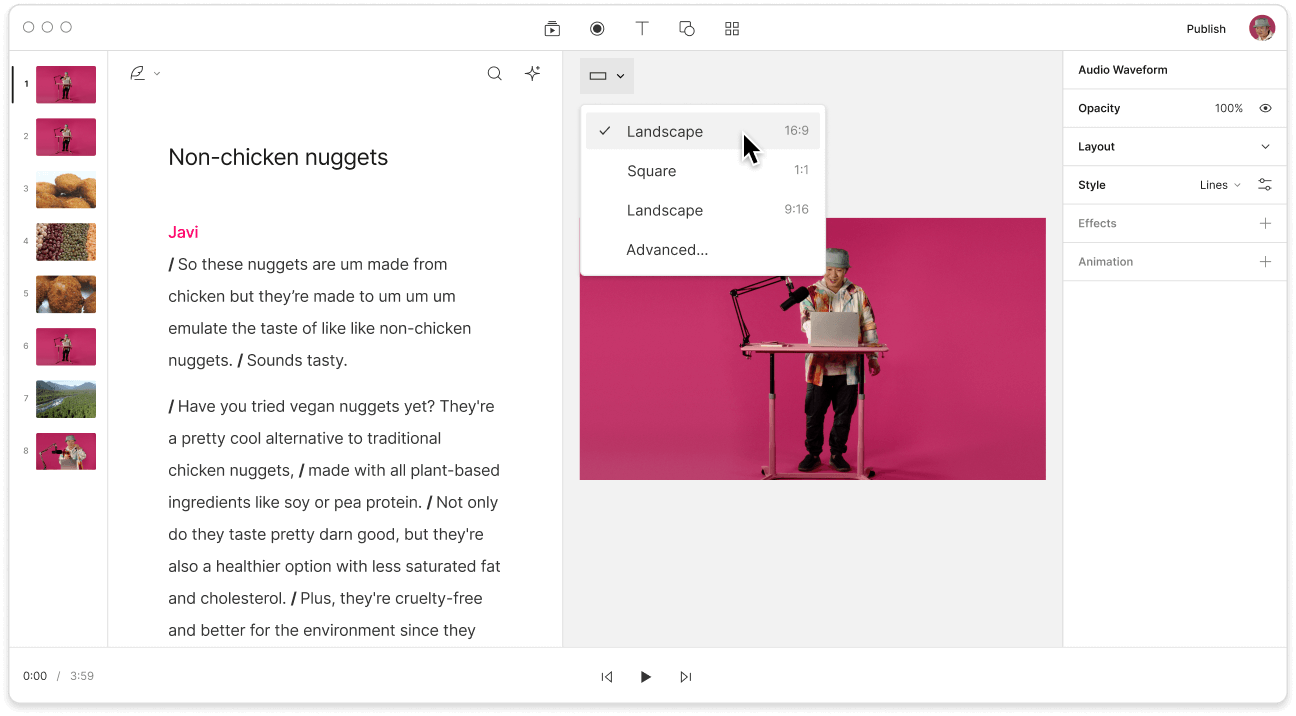If you’re used to long-form platforms like YouTube or podcasts, where do you start if you want to start publishing short-form video on Instagram Reels, TikTok, or YouTube Shorts?
Short-form video content is massively popular, and many creators are flocking to vertical platforms to reach new audiences. The medium is appealing because it's incredibly shareable, requires a limited time commitment, and offers potentially massive audiences.
But creators often miss the important differences in editing vertical content. Platforms like TikTok require different creative considerations.
This article will go through basic rules of editing short videos, as well as tips to keep your content engaging.
Best practices for short-form video
Short-form video platforms have their own rules—both formally, in the form of time limits and technical requirements, and informally, in the form of audience preferences and trends. For your short-form video to be successful, you'll want to know these rules inside and out.
1. Adhere to time limits
Each platform has its own maximum video length, which can sometimes change.
- Instagram Reels: The platform has a hard limit of 90 seconds.
- YouTube Shorts: YouTube caps these uploads at 3 minutes.
- TikTok: While the platform’s maximum is currently 10 minutes, they’ve reportedly been testing 15 and 30 minute uploads.The app is constantly pushing up its maximum upload length.
2. Use the right orientation
For Tiktok, Reels, and Shorts, use a 9:16 aspect ratio - or a vertical orientation. If you’re editing something filmed in another aspect ratio, make sure you’re not cropping out the key action or speaker. Descript offers a convenient tool to quickly resize your videos.

3. Record vertically
You can resize horizontal content, but it's always preferable to record in the actual format you're going to post with. If you want to post on both horizontal and vertical platforms, you can try using two recording devices (like a phone and a camera) set up with each respective orientation to capture both simultaneously. If you have access to more expensive camera equipment, you can also record in a higher resolution (such as 4K) and crop into a vertical orientation without losing quality.
4. Be careful repurposing
Not all long-form content works well on short-form platforms, even when turned into individual clips. It’s best to tailor your content for each platform.
Descript video creator Ramdy Marte agrees that posting snippets to social media "could be a great way to increase discoverability."
"The key is, you have to play by their rules. So don't just blindly copy and paste the clip onto TikTok, for example," he said.
For example, check out the long-form YouTube version of Descript's AI Eye Contact announcement and compare it to the short-form TikTok version.
Pay attention to the ways other creators use on-screen text, background effects, or sounds to succeed on the platform. You may not have to create an entirely new video, but these considerations can help your pre-existing content succeed.
5. Don't over-polish
It can be tempting to edit your short videos with eye-catching transitions and beautifully designed graphics. And that can succeed on platforms like TikTok, but you also risk seeming out of place on a medium that favors authenticity and a more unpolished aesthetic.
Many of the most popular short-form videos are full of messy green-screen effects and filters, not to mention creators doing the otherwise-verboten practice of taping microphones to pencils or recording themselves from bed. Don't be afraid to leave your videos a little unfinished.
6. Use captions
Most platforms offer automatic captioning tools, which are a must. Be sure to check them and correct any errors. Burned-in captions are also encouraged, but more on that further down.
7. Be authentic
Don't think you can get away with being someone (or something) else—you almost certainly can't. Don't try to talk or present like you think other people do, and don't force yourself into participating in trends that don't make sense for you. Are you a mediocre dancer? Maybe sit this one out as more qualified people do the Rasputin dance. In short, don't be the "Fellow Kids" meme.
8. Post regularly
Succeeding on vertical platforms is often about building a relationship with your audience. If you're posting every six months, that can be difficult. Like all rules, there are exceptions, but holding yourself to a specific cadence can be a helpful creative tool.
9. Use sounds appropriately
The sound and music libraries on platforms like TikTok are an incredible tool. You don't need to re-invent the wheel—just find similar creators to see what popular sounds they're using and how. But for plenty of genres, music and sounds aren't required to succeed on the platform.
10. Find your niche
Viewers will often follow creators with a specific expectation of what kind of content they're getting. Veering from that niche can alienate your viewers, although sometimes it can simultaneously attract newer (and larger) audiences—for better and for worse.
As a creator, it's important to figure out exactly what you're offering to viewers, and how it differs from others in your niche.
How to edit for the most engaging short-form video
Start with a strong hook
Viewers will decide to keep swiping in just a few seconds on TikTok. Make sure that in the first 3 seconds there’s something to captivate the viewer. A common strategy is to present a mystery or pose a question.
Cut dead air
To make your pacing as quick as possible, remove ums and long pauses. Even transitions that drag on too long give the viewer an opportunity to disengage.
Keep it fast-paced
For Marte, pacing is the biggest differentiator from long-form. "They’re cut quicker and are more visually engaging, while long-form content has more leniency on pacing," he said.
In short-form video, viewers will have less patience for tangents, backstories, or drawn-out context. If videos take too long to get to the point, viewers can simply swipe to the next video. While some may view this as an unbearable creative constraint, it's good to keep in mind the classic writing advice to "omit needless words” also applies to editing.
Include captions
Captions can allow people to consume your content without sound, and also can help people with hearing difficulties. Also, more and more people simply prefer to consume content with captions.
Many viewers of short-form content "are in waiting rooms, on the subway, heck, in class," Marte said. "So being able to still understand a video when your phone is muted is a big plus."
Many platforms provide automatic captioning tools. These will often be imperfect, so it’s crucial to check them for accuracy. Other creators use “burned-in” captions, meaning they can’t be turned on or off like traditional subtitles. With burned-in captions, you can adjust the font, color to make your video more visually appealing.
Burned-in captions are incredibly easy to add in Descript, since automatic transcription ensures that the text is already there when you need it.
Include graphics
On-screen imagery can give visual variety and keep viewers engaged. It doesn’t have to be anything fancy. Plenty of vertical videos feature a person talking in front of a website screenshot or a chart.
Marte suggests strategically zooming in and out of shots to emphasize certain points and keep viewers engaged, and taking advantage of the many green screen tools available to creators.
Be relevant
Whether you're explaining medieval history or showing off soup recipes, you need to figure out how to make your content timely and relevant. That might mean tying your content to a current event or trending debate, reacting to other popular content on the platform, or doing your own version of popular trends.
FAQ
What is a short-form video?
A short-form video is a video that is usually under 90 seconds in length, although definitions may vary. Short-form video is defined by a vertical orientation due to the success of TikTok, although they are now massively popular on YouTube Shorts and Instagram Reels.
What does "short" mean in video?
The “short” in “short-form video” generally refers to a length of under 90 seconds. While some define “short” as under 60 seconds, each platform's upload limits contribute to shifting definitions.
How do I make a short video?
Making short videos is easy on platforms like TikTok, Instagram Reels, and YouTube Shorts. For beginners, you can record from your phone and edit in each respective app. These platforms allow you to easily add music and offer a variety of ways to add on-screen graphics. You can also film separately, on your phone or a camera, and use editing software like Descript.
Do I need editing experience to make short videos?
No. The major short-form video platforms all offer simple and intuitive ways to cut and splice your video. Having prior editing experience can be helpful, but is not necessary.
Can I upload my short videos with a computer?
Yes, you can upload your short videos with a computer. Instagram Reels, TikTok, and YouTube Shorts all allow uploads through a computer, rather than your phone. This is preferable if you've already edited your video in separate software like Descript.
Can I use any song in my short video?
No, the songs you use in short-form video need to be in the library of the respective platform. Platforms like TikTok negotiate with music distributors and offer royalties for songs in their libraries. However, these deals can be subject to change, like when Universal Music Group pulled all of their music from TikTok.

































%20(1).JPG)





